Pointillism: Seurat's Grande Jatte and Circus
What was different in the way this group of younger painters reacted to the color theories of Chevreul and other writers? How were they able to profit from Impressionist methods while reacting against some of their practices?
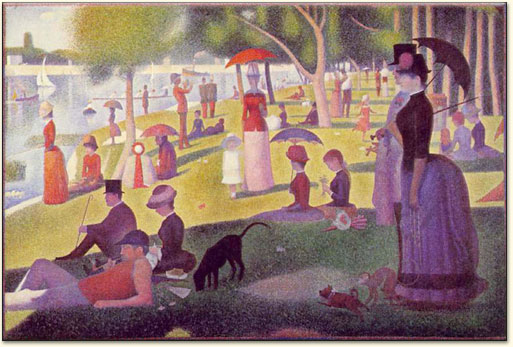
Sunday Afternoon on the Island of La Grande Jatte (Un dimanche après-midi à l’Ile de la Grande Jatte), Georges Seurat, 1884-1886.
Let us look at the painting Un Dimanche a la Grande Jatte. The painting represents a Sunday on the island of the Grande Jatte. The work is often referred to as his “Manifesto Painting,” and is even noted as such by contemporary critics. It was large in size, the first painting to be executed entirely in the Pointillist technique and the first to include a great many people playing a major role.
Every detail is carefully planned. The work required sketches on panel, 25 drawings and three important preliminary studies. Look at the illustration to see the contrast in technique with the slightly earlier painting (1884). Instead of workers enjoying themselves, this is strangely formal; figures are mostly seen in profile or frontal position. They seem rather like toy soldiers, an artificiality noted at the time. One critic wrote that the painting showed, “The banal promenade that people in their Sunday best take… in the places where it is accepted that one should stroll on a Sunday.”
Also, note the use of color and technique of using “the dot.” The skirt of the woman in the center with a parasol is painted in an orange-pink hue. It casts a blue shadow. Her red jacket is seen against bright green grass. The orange dress of the young girl running (to the right) has a blue-tinted shadow. The skirt of the woman with a parasol walking beside a man is predominantly purple — so it seems — but is made up of a myriad of hues. Notice the lighter yellowish “halo” separating the skirt from the foreground grass, particularly just behind her skirt. At the same time, Seurat defines form by brushstrokes: close, parallel strokes define the contour of the woman’s bustle. He continuously experiments in his manner of applying paint; in the sunlit grass, for example, short, even strokes are laid over one another. It is clear that Seurat never followed any of the popular theories rigidly.
His paintings are also intended to convey social commentary. The Grande Jatte makes use of symbols. A monkey in French (and female) is known as “singesse,” denoting a prostitute. The smartly dressed woman is fishing — but for what? Then, as now, spectators have questioned Seurat’s meaning. Whether Seurat intended the Bathers and this painting to be considered as pendants (a pair) is still debated; certainly he contrasts the natural world with the unpleasant artificiality of bourgeois life, as these artists saw it.
However, the critics applauded such elements as the controlled surface of the painting, the use of aerial perspective, which gives an impression of space, and Seurat’s deeply shadowed foreground that leads into a light, bright distance.
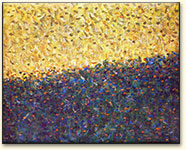
Detail of the Grand Jatte, above the dog. |
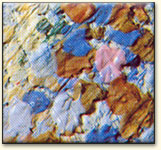
Close-up of the paint on canvas in the Grand Jatte. |
Strictly speaking, Pointillism refers to the technique of using dots of pure color in such a way that, seen at the appropriate distance, they achieve maximum luminosity. However, a pointillist painting is no more “luminous” than anything else that is printed with small dots, such as a magazine photograph. You can see the dots above.
Divisionism is a broader term meaning that it is possible to obtain brighter hues of color such as green, orange and purple, by a series of dots (or blobs) of both primary colors so that they are optically intermingled in the spectator’s eye (rather than being pre-mixed). The artists prefer the term Neo-Impressionism (again, coined by a critic — this time Felix Feneon) as a description of their work.
The following example, Seurat’s The Circus, is an excellent example of Divisionism. Be sure to enlarge the detailed images.
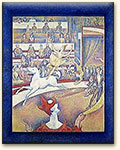
|
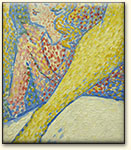
|
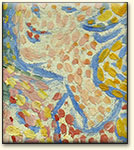
|
The Circus, Georges Seurat, 1890-91. Full painting, and two detailed views. This appears to be the first painting in which Seurat shows his debt to the newly-developed art of the poster, in particular the celebrated Cheret. |
||
The circus theme was often covered in the 1880s, especially by Renoir, Degas and Toulouse-Lautrec. However, Seurat’s Circus, far from a merely anecdotal rendering of a modern form of entertainment, constitutes one of the most impressive applications of Divisionist theory.